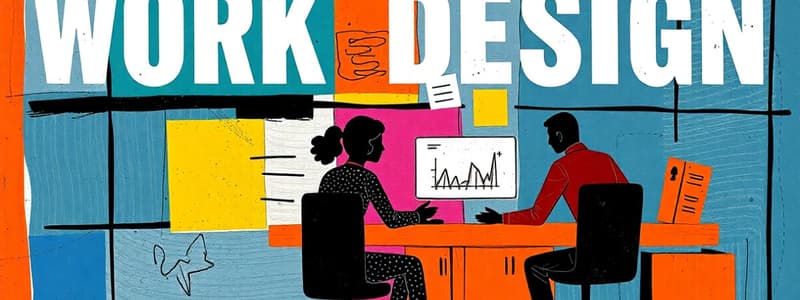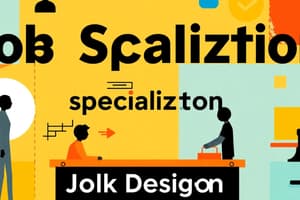Podcast
Questions and Answers
Which of the following is NOT a major work design perspective discussed in the text?
Which of the following is NOT a major work design perspective discussed in the text?
- Job Crafting (correct)
- Time and Motion Studies
- Scientific Management
- Job Demands-Control-Support Model
Early work design theories focused solely on maximizing efficiency and minimizing costs, without considering employee well-being.
Early work design theories focused solely on maximizing efficiency and minimizing costs, without considering employee well-being.
True (A)
What is the primary goal of work design?
What is the primary goal of work design?
To determine the framework conditions for employee work performance.
The concept of "______" by Frederick Taylor involved breaking down work tasks into their simplest components.
The concept of "______" by Frederick Taylor involved breaking down work tasks into their simplest components.
According to Herzberg's two-factor theory, which of the following is considered a motivator?
According to Herzberg's two-factor theory, which of the following is considered a motivator?
The job characteristics model and the demand-control model emphasize the importance of employee control and variety in work design.
The job characteristics model and the demand-control model emphasize the importance of employee control and variety in work design.
Match the following historical figures with their respective contributions to work design:
Match the following historical figures with their respective contributions to work design:
Sociotechnical Systems Theory suggests that social and technical systems should be developed separately for optimal results.
Sociotechnical Systems Theory suggests that social and technical systems should be developed separately for optimal results.
What was a major drawback of early work design approaches?
What was a major drawback of early work design approaches?
Which of the following is NOT a major approach in work design theory according to Morgeson et al. (2013)?
Which of the following is NOT a major approach in work design theory according to Morgeson et al. (2013)?
What is the core idea behind the scientific management approach to work design?
What is the core idea behind the scientific management approach to work design?
Modern work design theories are primarily concerned with maximizing efficiency and minimizing costs.
Modern work design theories are primarily concerned with maximizing efficiency and minimizing costs.
What is the primary assumption of the Social Information Processing Perspective?
What is the primary assumption of the Social Information Processing Perspective?
How did the work design used in Henry Ford’s Model T production demonstrate the potential drawbacks of early approaches?
How did the work design used in Henry Ford’s Model T production demonstrate the potential drawbacks of early approaches?
The ______ approach to work design aims to align work with higher-order needs of employees, focusing on humane work design.
The ______ approach to work design aims to align work with higher-order needs of employees, focusing on humane work design.
The ______ of Human Relations at the Tavistock Institute led to the development of Sociotechnical Systems Theory.
The ______ of Human Relations at the Tavistock Institute led to the development of Sociotechnical Systems Theory.
Which of the following is NOT a design recommendation based on Sociotechnical Systems Theory?
Which of the following is NOT a design recommendation based on Sociotechnical Systems Theory?
Match the following work design theories with their key proponents:
Match the following work design theories with their key proponents:
What is a key characteristic of the job characteristics model?
What is a key characteristic of the job characteristics model?
Match the following theories with their key assumptions:
Match the following theories with their key assumptions:
What is the main focus of the demand-control model?
What is the main focus of the demand-control model?
According to Social Information Processing Theory, objective working conditions are more important than social information in shaping individuals' perceptions and reactions to work.
According to Social Information Processing Theory, objective working conditions are more important than social information in shaping individuals' perceptions and reactions to work.
In what two ways does the social environment influence individuals according to Social Information Processing Theory?
In what two ways does the social environment influence individuals according to Social Information Processing Theory?
The ______ theory argues that employees are motivated by factors related to the work itself, such as achievement and recognition, while other factors like salary and working conditions act as hygiene factors.
The ______ theory argues that employees are motivated by factors related to the work itself, such as achievement and recognition, while other factors like salary and working conditions act as hygiene factors.
The Job Demands-Control-Support Model argues that increasing work demands always leads to a reduction in job satisfaction.
The Job Demands-Control-Support Model argues that increasing work demands always leads to a reduction in job satisfaction.
Which of the following is NOT a core element of the Job Demands-Resources Model?
Which of the following is NOT a core element of the Job Demands-Resources Model?
What does the mechanistic model of job design assume about work efficiency?
What does the mechanistic model of job design assume about work efficiency?
The ______ model of job design suggests that job satisfaction can be increased by enriching work through task variety.
The ______ model of job design suggests that job satisfaction can be increased by enriching work through task variety.
Match each work design model with its primary focus:
Match each work design model with its primary focus:
According to the Job Characteristics Model, which of the following is a key factor in determining job satisfaction?
According to the Job Characteristics Model, which of the following is a key factor in determining job satisfaction?
The Job Characteristics Model is an example of an interdisciplinary model of work design.
The Job Characteristics Model is an example of an interdisciplinary model of work design.
What is a key difference between the Job Demands-Control-Support Model and the Job Demands-Resources Model?
What is a key difference between the Job Demands-Control-Support Model and the Job Demands-Resources Model?
Which of the following is NOT a core job characteristic identified in the job characteristics model?
Which of the following is NOT a core job characteristic identified in the job characteristics model?
According to the job characteristics model, high growth need strength (GNS) moderates the relationship between job characteristics and outcomes, meaning that individuals with higher GNS will experience a stronger relationship between these factors.
According to the job characteristics model, high growth need strength (GNS) moderates the relationship between job characteristics and outcomes, meaning that individuals with higher GNS will experience a stronger relationship between these factors.
What are the three critical psychological states that the job characteristics model suggests are influenced by the five core job characteristics?
What are the three critical psychological states that the job characteristics model suggests are influenced by the five core job characteristics?
The motivational potential score (MPS) is calculated by multiplying the average of [BLANK] by autonomy and job feedback.
The motivational potential score (MPS) is calculated by multiplying the average of [BLANK] by autonomy and job feedback.
Which of the following is NOT a desired outcome variable linked to the three critical psychological states in the job characteristics model?
Which of the following is NOT a desired outcome variable linked to the three critical psychological states in the job characteristics model?
Match the following job characteristics with their definitions:
Match the following job characteristics with their definitions:
Research has consistently shown that jobs with a high MPS always lead to higher motivation than jobs with a lower MPS.
Research has consistently shown that jobs with a high MPS always lead to higher motivation than jobs with a lower MPS.
What is the main conclusion of the meta-analysis by Loher et al. (1985) regarding the relationship between job characteristics, job satisfaction, and GNS?
What is the main conclusion of the meta-analysis by Loher et al. (1985) regarding the relationship between job characteristics, job satisfaction, and GNS?
According to the job demand-control model, which type of job is characterized by low demands and high job control?
According to the job demand-control model, which type of job is characterized by low demands and high job control?
The job demand-control model was developed by ______ in 1979.
The job demand-control model was developed by ______ in 1979.
The job demand-control-support model is an extension of the original job demand-control model, incorporating the additional resource of social support.
The job demand-control-support model is an extension of the original job demand-control model, incorporating the additional resource of social support.
Describe the 'strain hypothesis' as formulated by the job demand-control model.
Describe the 'strain hypothesis' as formulated by the job demand-control model.
Match the following job types with their corresponding characteristics based on the job demand-control model:
Match the following job types with their corresponding characteristics based on the job demand-control model:
Which of the following is NOT a core hypothesis of the job demand-control model?
Which of the following is NOT a core hypothesis of the job demand-control model?
The job demand-control-support model proposes that ______ can buffer the negative effects of high stress.
The job demand-control-support model proposes that ______ can buffer the negative effects of high stress.
High job demands are more likely to lead to job strain when job control is also high.
High job demands are more likely to lead to job strain when job control is also high.
Flashcards
Job Characteristics Model
Job Characteristics Model
A theory that outlines how job characteristics influence employees' psychological states and outcomes.
Demand-Control Model
Demand-Control Model
A model proposing that job demands and control affect stress and well-being.
Psychological States
Psychological States
The mental conditions influenced by job characteristics, affecting attitudes and behaviors.
Job Satisfaction
Job Satisfaction
Signup and view all the flashcards
Scientific Management
Scientific Management
Signup and view all the flashcards
Job Enrichment Approaches
Job Enrichment Approaches
Signup and view all the flashcards
Motivator-Hygiene Theory
Motivator-Hygiene Theory
Signup and view all the flashcards
Interdisciplinary Model of Job Design
Interdisciplinary Model of Job Design
Signup and view all the flashcards
Work Design
Work Design
Signup and view all the flashcards
Job Demands-Control-Support Model
Job Demands-Control-Support Model
Signup and view all the flashcards
Job Demands-Resources Model
Job Demands-Resources Model
Signup and view all the flashcards
Job Crafting
Job Crafting
Signup and view all the flashcards
Time and Motion Studies
Time and Motion Studies
Signup and view all the flashcards
Humanistic Approach
Humanistic Approach
Signup and view all the flashcards
Holistic Approach
Holistic Approach
Signup and view all the flashcards
Self-actualization
Self-actualization
Signup and view all the flashcards
Motivators
Motivators
Signup and view all the flashcards
Hygiene factors
Hygiene factors
Signup and view all the flashcards
Socio-technical systems theory
Socio-technical systems theory
Signup and view all the flashcards
Autonomy in tasks
Autonomy in tasks
Signup and view all the flashcards
Social Information Processing Theory
Social Information Processing Theory
Signup and view all the flashcards
Impact of social cues
Impact of social cues
Signup and view all the flashcards
Job Demand-Control Model
Job Demand-Control Model
Signup and view all the flashcards
Low Strain Job
Low Strain Job
Signup and view all the flashcards
High Strain Job
High Strain Job
Signup and view all the flashcards
Passive Job
Passive Job
Signup and view all the flashcards
Active Job
Active Job
Signup and view all the flashcards
Strain Hypothesis
Strain Hypothesis
Signup and view all the flashcards
Buffer Hypothesis
Buffer Hypothesis
Signup and view all the flashcards
Job Characteristics
Job Characteristics
Signup and view all the flashcards
Motivational Potential Score (MPS)
Motivational Potential Score (MPS)
Signup and view all the flashcards
Growth Need Strength (GNS)
Growth Need Strength (GNS)
Signup and view all the flashcards
Job Performance Outcomes
Job Performance Outcomes
Signup and view all the flashcards
Additive Combination
Additive Combination
Signup and view all the flashcards
Meta-Analysis
Meta-Analysis
Signup and view all the flashcards
Differentiable Job Characteristics
Differentiable Job Characteristics
Signup and view all the flashcards
Mechanistic Model
Mechanistic Model
Signup and view all the flashcards
Motivational Model
Motivational Model
Signup and view all the flashcards
Perceptual Model
Perceptual Model
Signup and view all the flashcards
Biological Model
Biological Model
Signup and view all the flashcards
Study Notes
Work Design
- Work design is the content and organization of work tasks, activities, relationships, and responsibilities.
- The study investigates work design's history and major approaches.
- Key models such as the job demands-control-support model are examined.
- Job crafting, a concept where employees actively shape their work, is discussed.
- Four strategies of job crafting are detailed:
- Increase structural resources
- Increase social resources
- Increase challenging requirements
- Decrease obstructive demands
History of Work Design
- Early work design focused on efficiency, such as Taylor's scientific management and Gilbreth's time-motion studies.
- Modern approaches are more humanistic and holistic.
- Important theories include the job characteristics model and the demand-control model, which consider job characteristics' impact on psychological states and employee attitudes.
Major Work Design Perspectives
- Scientific management: Focuses on optimizing work tasks for efficiency.
- Job enrichment: Aims to align work with higher-order needs.
- Sociotechnical systems theory: Emphasizes integrating social and technical systems for optimal results and employee autonomy.
- Social information processing perspective: Highlights the social construction of meaning in work and its impact on individuals.
- Job demands-control-support and job demands-resources models focus on job demands and resources' role in stress response and employee well-being.
- Interdisciplinary model combines different perspectives for a holistic view.
Job Characteristics Model
- Identifies five core job characteristics (skill variety, task identity, task significance, autonomy, feedback) linked to psychological states and desired outcomes.
- A higher motivational potential score (MPS) is associated with better outcomes.
Job Demand-Control Model
- Two key factors: job demands and job control.
- Strain hypothesis: High demands and low control lead to higher strain.
- Buffer hypothesis: Job control helps buffer strain caused by demands.
- Social support can be included as another crucial dimension.
- Leads to different job classifications (passive, low strain, active, high strain.)
SMART Work Design
- Integrates previous research for a comprehensive model.
- Addresses four key areas: stimulating, mastery, agency, and tolerable demands.
Job Crafting
- Employees take initiative and actively shape their work.
- Includes three types of crafting: task, relational, and cognitive crafting.
- Strategies: increasing structural resources, social resources, challenging requirements, and decreasing obstructive demands.
Studying That Suits You
Use AI to generate personalized quizzes and flashcards to suit your learning preferences.




